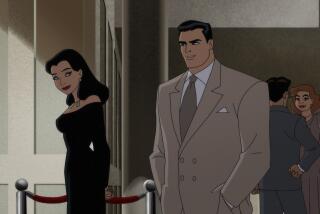Captain America, RIP
- Share via
FORGET THE endless congressional debates about Iraq. The most telling measure of America’s current distemper can be found in a more mundane place — in the gory assassination of Captain America in issue No. 25, which hit the stands Wednesday.
The startling demise of Captain America, who until recently had been leading an underground insurgency against a government 9/11-style “Superhuman Registration Act” that forced superheroes to divulge their secret identities, captures the growing sense that America itself is floundering in the war on terrorism.
That message hasn’t been missed by conservatives such as Michael Medved, who complains that Captain America is setting a terrible example for America’s youth by turning soft on terrorism and is “anti-American.” But a look at Captain America’s evolution over the decades suggests he should not be dismissed so easily. In fact, Marvel Comics has almost always had a perfect feel for America and its moods.
Over the years, Captain America’s story has accurately reflected U.S. attitudes, as our country moved from the self-confidence of the early Cold War to the guilt-ridden angst of the 1970s to the revival of national pride that characterized the Reagan 1980s.
Unlike Superman, who was created in the midst of the Depression, Captain America was a direct product of the fight against Nazism. The creation of Joe Simon and Jack Kirby, the comic debuted in 1941, just months before the U.S. officially entered World War II.
A prototypical 99-pound weakling who suffers the ultimate humiliation of being rejected as too frail for military service and stamped 4-F, Steve Rogers promptly volunteers for a U.S. government experiment run by a scientist code-named Professor Reinstein, who is concocting a “super serum” to create a new cadre of soldiers.
Rogers, whose wimpiness makes him the perfect candidate, is whisked away to a secret laboratory in Washington, where he is injected with the super serum and zapped with “vita-rays.” Rogers, however, remains the New Deal everyman in spirit. He has the ability to bench press 800 pounds, amazing agility and indomitable willpower — but no supernatural powers. His only weapons are his fists and his invulnerable shield.
Captain America and his sidekick, Bucky Barnes, are sent off to battle the Nazis, and throughout the war, they daringly go behind the lines to administer a pasting to Hitler and his minions. It is only near the end of the war that Rogers and Bucky fall from a Nazi plane into the Arctic.
In the 1950s, a few issues appeared, but the strip went nowhere as comics focused on horror stories. It took Marvel mastermind Stan Lee to revive Captain America. In 1964, Captain America, who had been frozen in a block of ice, is fished out of the North Atlantic by the new superhero group “The Avengers.” They realize that Captain America had remained in a state of suspended animation that prevented him from aging.
Initially, Rogers, the perfect square, fits in perfectly with the early 1960s Cold War ethos, battling the bad guys who seek to destroy the American way of life. But it was only when Rogers’ complacent view of U.S. society and government was undermined by the Vietnam War and the rise of the counterculture that the comic book really took off. By the mid-1970s, the credulous square had been replaced by a disillusioned cynic. The brilliantly imaginative writer Steve Englehart had Captain America exposing a kind of Watergate — a “Secret Empire,” complete with a Committee to Regain America’s Principles (CRAP), in a play on Nixon’s real-life Committee to Re-elect the President (CREEP).
The Secret Empire series reaches its climax with Captain America racing into the White House to apprehend the leader of the Secret Empire, only to discover to his horror that the leader is, in fact, the president himself — Richard Nixon, of course, although he’s not depicted. A disillusioned and heartbroken Captain America hangs up his uniform and shield to adopt a new persona — “Nomad.” Like the U.S. itself, Nomad is in search of his true identity now that the ideals he once believed in have been besmirched.
By the 1980s, the crisis is over. In truth, by this time, Marvel Comics had turned Captain America into something of a neoconservative. Marvel caught the rah-rah spirit of the Reagan years, offering a stirring retelling by the traditionally minded artist John Byrne of Captain America’s origins in its 40th anniversary issue in 1981. The issue, which features a 1940s-style heroic cover, ends with a contemporary Captain America returning to his Brooklyn apartment, wondering whether it’s actually worth the effort to be a superhero. Then the television blares forth the strains of “The Star Spangled Banner.” “It’s worth it,” Captain America proudly says to himself. The time for questioning authority has passed.
Cut to 2007. Today, in his latest incarnation, Captain America has morphed yet again, this time into the champion of the common man — defending individual liberty against an oppressive government that he once loyally served. To his credit, he calls on his troops to surrender once he sees the general devastation taking place in Manhattan. “We’re not fighting for the people anymore,” he says. “We’re just fighting.” Sound familiar?
Gunned down by a mysterious sniper in the latest issue as he’s entering a Manhattan federal courthouse to be arraigned, Captain America symbolizes the death of the American dream. Can he and it come back? Of course! Captain America will no doubt be resurrected as soon as the country has recovered from its current fiasco. Until then, it seems hard to believe that the dark world portrayed by Marvel won’t be sharply at odds with the heroic Army advertisement featured on the back of issue No. 25 of Captain America.
More to Read
The biggest entertainment stories
Get our big stories about Hollywood, film, television, music, arts, culture and more right in your inbox as soon as they publish.
You may occasionally receive promotional content from the Los Angeles Times.










